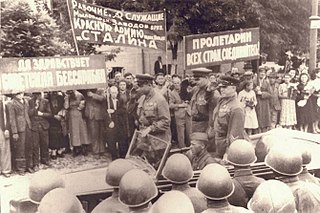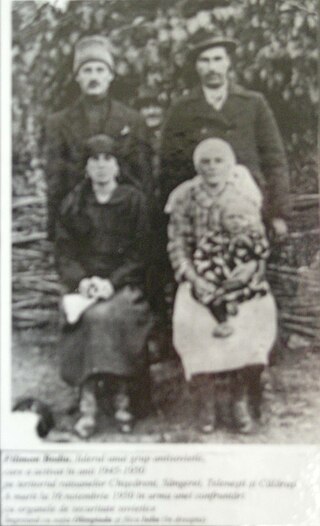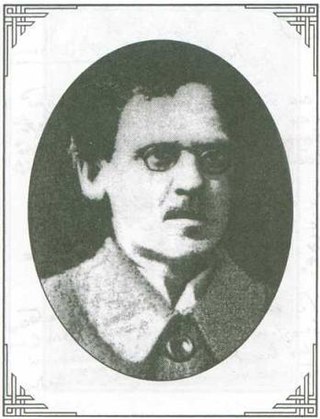Related Research Articles

This article represents an overview on the history of Romanians in Ukraine, including those Romanians of Northern Bukovina, Zakarpattia, the Hertsa region, and Budjak in Odesa Oblast, but also those Romanophones in the territory between the Dniester River and the Southern Buh River, who traditionally have not inhabited any Romanian state, but have been an integral part of the history of modern Ukraine, and are considered natives to the area. There is an ongoing controversy whether self-identified Moldovans are part of the larger Romanian ethnic group or a separate ethnicity.
The Fântâna Albă massacre took place on 1 April 1941 in Northern Bukovina when up to 3,000 civilians were killed when their attempt to forcefully cross the border from the Soviet Union to Romania, near the village of Fântâna Albă, now in Chernivtsi Oblast, Ukraine, was met with open fire by the Soviet Border Troops. Although according to Soviet official reports no more than 44 civilians were killed, local witnesses assert a much higher toll, stating that survivors were tortured, killed, or buried in mass graves. Other survivors were allegedly taken away to be tortured and killed at the hands of the NKVD, the Soviet secret police. Some sources refer to this massacre as "the Romanian Katyn".

The Metropolis of Chișinău and All Moldova, also referred to as the Moldovan Orthodox Church, is an autonomous metropolitanate under the Russian Orthodox Church. Its canonical territory is the Republic of Moldova.

The Soviet occupation of Bessarabia and Northern Bukovina took place from June 28 to July 3, 1940, as a result of an ultimatum by the Soviet Union to Romania on June 26, 1940, that threatened the use of force. Bessarabia had been part of the Kingdom of Romania since the time of the Russian Civil War and Bukovina since the dissolution of Austria-Hungary, and Hertsa was a district of the Romanian Old Kingdom. Those regions, with a total area of 50,762 km2 (19,599 sq mi) and a population of 3,776,309 inhabitants, were incorporated into the Soviet Union. On October 26, 1940, six Romanian islands on the Chilia branch of the Danube, with an area of 23.75 km2 (9.17 sq mi), were also occupied by the Soviet Army.

Alexandru Baltagă was a Bessarabian Romanian Orthodox priest, a founder of the Bessarabian religious press in the Romanian language, a member of Sfatul Țării (1917–1918), a Soviet political prisoner, and, according to the Orthodox Church, a martyr for the faith.
The Bridge of Flowers was a massive demonstration that took place on Sunday, 6 May 1990 along the Prut River separating Romania and the Moldavian SSR.
Grigore Turcuman was a Bessarabian Romanian politician. As a member of Sfatul Țării, he voted the Union of Bessarabia with the Kingdom of Romania on 27 March 1918.

Anton Crihan was a Bessarabian politician, lawyer, author, economist, professor and journalist. He was a member of Sfatul Țării (1917), adviser to the Secretary of State for Agriculture in the General Directorate of the Republic of Moldova (1917), deputy in the Parliament of Romania, adviser to the Secretary of State at the Ministry of Agriculture and Domains (1932–1933), professor at the Polytechnic University of Iasi and at the Faculty of Agronomy in Chisinau (1934–1940).

Olimpiada Bodiu (1912–1971) was a Bessarabian activist and member of an anti-communist resistance group in the former Moldavian Soviet Socialist Republic.
Elena Postică is a historian from the Republic of Moldova.

Viaţa Basarabiei is a Romanian-language periodical from Chişinău, Moldova. Originally a literary and political magazine, published at a time when the Bessarabia region was part of Romania, it was founded in 1932 by political activist Pan Halippa and writer Nicolai Costenco. At the time, Viaţa Basarabiei was primarily noted for rejecting the centralism of Greater Romanian governments, to which they opposed more or less vocal Bessarabian regionalist demands and a nativist ethos.

Ion Țurcanu is an author, educator, historian, memoirist, professor, former member of the Parliament (1990–1994), politician and Romanian writer from Moldova. He is one of the 277 MPs of the first parliament of the former RSS Republic, who voted for the Declaration of Independence of the Republic of Moldova on 27 August 1991.
Vasile Soare is a Romanian diplomat. Ambassador Extraordinary and Plenipotentiary of Romania to Azerbaijan since October 28, 2021.

Iustin Ștefan Frățiman, also known as Frațman or Frățimanu, was a historian, educator, librarian and political figure from Bessarabia, active in the Russian Empire and the Kingdom of Romania. After receiving a classical education, he worked for various seminaries of the Russian Orthodox Church, moving as far north as Olonets. Frățiman had settled in Soroca by the time of World War I, becoming a champion of Romanian nationalism. This resulted in his being exiled to Central Asia until 1917. Allowed back home after the liberal February Revolution, he resumed his activism, openly campaigning for the national rights of Romanians east of Bessarabia. He was afterwards one of the educators tasked with institutional Romanianization by the Moldavian Democratic Republic.
Vladimir Vladimirovich Tsyganko was a Bessarabian, and later Soviet, politician. The son of a distinguished architect, and himself an engineer by vocation, Tsyganko entered politics shortly before the proclamation of a Moldavian Democratic Republic, when he earned a seat in the republican legislature. He sided with the parliamentary Peasants' Faction, which supported left-wing ideals and pushed for land reform, being generally, and radically, opposed to the more right-wing Moldavian Bloc. Tsyganko was skeptical of the Bloc's plan to unite Bessarabia with Romania, although he possibly supported a federation. His uncompromising stance divided his Faction and led the Romanian Kingdom's authorities to identify him as a major obstruction to the unionist cause.

Ieremia Teodor Cecan was a Bessarabian-born Romanian journalist, Bessarabian Orthodox priest and political figure. During the first part of his life, he was active in the Bessarabia Governorate of the Russian Empire, earning his reputation as a Christian philanthropist and putting out the pioneering church magazine Nashe Obyedineniye. His opposition to Russification and his advocacy of social improvement led to a public scandal and then to is demotion by church officials, and pushed Cecan into independent journalism. However, his sympathies remained with the conservative-antisemitic Union of the Russian People, developing into a critique of Romanian nationalism that was well liked by the imperial authorities. During the latter stages of World War I, Cecan was a chaplain in the Russian Army.

The Bukovina Governorate was an administrative unit of Romania during World War II.

Greater Moldova or Greater Moldavia is an irredentist concept today used for the credence that the Republic of Moldova should be expanded with lands that used to belong to the Principality of Moldavia or were once inside its political orbit. Historically, it also meant the unification of the lands of the former principality under either Romania or the Soviet Union. Territories cited in such proposals always include Western Moldavia and the whole of Bessarabia, as well as Bukovina and the Hertsa region; some versions also feature parts of Transylvania, while still others include areas of Podolia, or Pokuttia in its entirety. In its most post-Soviet iterations, "Greater Moldova" is associated with a belief that Moldovans are a distinct people from Romanians, and that they inhabit parts of Romania and Ukraine. It is a marginal position within the Moldovan identity disputes, corresponding to radical forms of an ideology polemically known as "Moldovenism".

"Bessarabia, Romanian land", "Bessarabia is Romanian land" or "Bessarabia is Romania" is a popular and commonly used Romanian nationalist and irredentist slogan posing claims over the geographical region of Bessarabia, today divided between the Republic of Moldova and parts of Ukraine. According to the Romanian newspaper Adevărul, the use of this slogan as a patriotic catchphrase started in 2006 from a group of anonymous young Romanians from Bucharest.
The Lunca massacre took place on 7 February 1941, in Northern Bukovina when hundreds of civilians were killed when Soviet Border troops opened fire on them while they were attempting to forcefully cross the border from the Soviet Union to Romania, near the village of Lunca, now in Chernivtsi Oblast, Ukraine. Although there are no official statistics, it is estimated that about 600 people were killed as a result of the massacre.
References
- 1 2 3 (in Romanian)Martiri pentru Hristos, din România, în perioada regimului comunist, Editura Institutului Biblic şi de Misiune al Bisericii Ortodoxe Române, București, 2007, pp. 34–35.
- ↑ (in Romanian)Ludmila Tihonov, Politica statului sovietic faţă de cultele din RSS Moldovenească (1944–1965), Editura Prut Internaţional, 2004, p.23–65
- ↑ (in Romanian)Alexandru Donos, Regimul sovietic şi Biserica Ortodoxă din Basarabia comunizată (1944–1953), in Partidul, Securitatea şi Cultele, 1945–1989, Adrian Nicolae Petcu Ed., București, Nemira, 2005, p. 337–349
- 1 2 (in Romanian)Martiri pentru Hristos, din România, în perioada regimului comunist, Editura Institutului Biblic şi de Misiune al Bisericii Ortodoxe Române, București, 2007, p. 764
- ↑ (in Romanian)Constantin I. Stan, Alexandru Gaiţă, Refugiaţi din Basarabia şi Bucovina de Nord la Râmnicu-Sărat, Buzău şi Mizil (1940–1941), in Destin românesc, an IV (1997), no. 2 (14), p. 79, cf. Ibidem above
- ↑ (in Romanian)Constantin I. Stan, Alexandru Gaiţă, Biserica Ortodoxă Română din Basarabia şi Bucovina de Nord în anii 1940–1941, in Destin românesc, an IV (1997), no. 3 (15), pp. 99–110, cf. Ibidem above
- ↑ (in Romanian) Constantin I. Stan, Alexandru Gaiţă, Biserica Ortodoxă Română din Basarabia şi Bucovina de Nord în anii 1940–1941, in Destin românesc, an IV (1997), no. 3 (15), pp. 99–110, cf. above
- ↑ (in Romanian)Alexandru Usatiuc-Bulgăre, Preoţi martiri ai Mitropoliei Basarabiei, in Literatura şi Arta, nr. 11 (2391), 13 martie 1997, Chişinău, p. 7, cf. above
- ↑ (in Romanian)Alfa şi Omega, an I, nr. 1, ianuarie 1995, p.5, cf. above